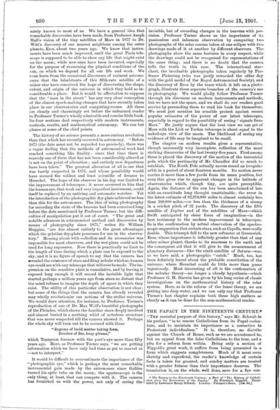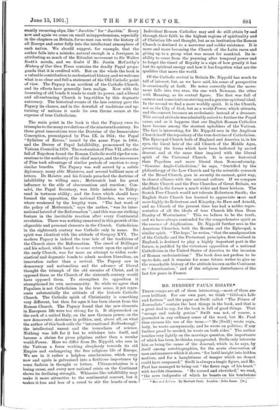THE PAPACY IN THE NINETEENTH CENTURY.* " THE essential purpose
of this history," says Mr. Schwab in his preface, " is to rescue Catholicism from its Papal carica- ture, and to maintain its importance as a corrective to Protestant individualism." It is, therefore, no diatribe- against the Church of Rome, such as we are accustomed to, but an appeal from the false Catholicism to the true, and a plea for a reform from within. Being only a section of Nippold's great work, it suffers from being presented in a form which suggests completeness. Much of it must seem. sketchy and superficial, the reader's knowledge of certain facts is taken for granted, and sundry matters are treated with a greater fulness than their importance deserves. The- translation is, on the whole, well done, save for a few con- 0 The Papacy in the Nineteenth Century : a Part of " The History of Catholi- cism since the Restoration of the Papacy." By Friedrich Nippold. Trans- lated by Lawrence Henry Schwab. London : Putnam's Sons. [10s. Bd.] stantly recurring slips, like " Jacobite" for " Jacobi." Every now and again we come on small misapprehensions, especially in the chapters on Britain, for no man can write the history of all Europe and enter fully into the intellectual atmosphere of each nation. We should suggest, for example, that the author falls into a mistake, natural enough in a foreigner, in attributing so much of the Ritualist movement to Sir Walter Scott's novels, and we doubt if Mr. Justin McCarthy's History of Our Own Times contains the deadly Papal propa- ganda that it is credited with. But on the whole the book is a valuable contribution to ecclesiastical history, and we welcome what is so clear and full a statement of the Old Catholic point of view. The Papacy is an accident of the Catholic Church, and its effects have generally been malign. Now with the loosening of old bonds it tends to exalt its power, and a liberal and all-embracing Church is hag-ridden by this dogmatic autocracy. The historical events of the late century gave the Papacy its chance, and in the downfall of traditions and up- turning of nations it made its own throne secure at the expense of true Catholicism.
The main point in the book is that the Papacy owes its triumphs to the many revolutions of the nineteenth century. Its three great innovations were the Doctrine of the Immaculate Conception, promulgated by Pius IX. in 1854; the Papal " Syllabus of Errors," issued by the same Pope in 1864; and the Decree of Papal Infallibility, pronounced by the Vatican Council in 1870. The restoration of Pius VII. after the fall of Napoleon found the Roman Catholic world ripe for con- cessions to the authority of its chief martyr, and the successors of Pius took advantage of similar periods of emotion to reap similar benefits. The Papacy was well served by a subtle diplomacy, many able Ministers, and several brilliant men of letters. De Maistre and his friends preached the doctrine of infallibility to willing ears ; Metternich lent his great influence to the side of obscurantism and reaction ; Con- salvi, the Papal Secretary, was little inferior to Talley- rand in tortuous ability ; and the force which should have formed the opposition, the national Churches, was every- where weakened by the lengthy wars. " The last word of the policy of Metternich," says the author, " was its inter- national hatred of the Reformation "; and this was one striking feature in the inevitable reaction after every Continental revolution. There was nothing unnatural in this growth of the oligarchic and personal elements in the Church. Catholicism in the eighteenth century was Catholic only in name. Its spirit was identical with the attitude of Gregory XVI. The modern Papacy is indeed the true heir of the traditions of the Church since the Reformation. The creed of Dellinger and his school, while based to some extent upon the spirit of the early Church, was far more an attempt to widen eccle- siastical and dogmatic bonds to admit modern liberalism, an innovation rather than a revival. The Papacy saw in democracy and nationalism and the advance of liberal thought the triumph of the old enemies of Christ, and it opposed them as the Church of the sixteenth century would have opposed them. To strengthen its opposition it strengthened its own sacrosanctity. So while we agree that Papalism is not Catholicism in the true sense, it yet repre- sents substantially the attitude of the historic Catholic Church. The Catholic spirit of Christianity is something very different, but then for ages it has been absent from the Roman Church. The Papacy found that the new elements in European life were too strong for it. It shipwrecked on the rock of a united Italy, on the new German power, on the new democratic doctrines in politics, and, above all, on what the author of this book calls the " international Kulturkampf," the intellectual unrest and the iconoclasm of science. Nothing was left for it but to withdraw into itself, and become a shrine for pious pilgrims rather than a secular world-Power. Here we differ from Dr. Nippold, who sees in the Vatican a force working sleeplessly towards its old Empire and endangering the free religious life of Europe. We see in it rather a helpless anachronism, which every now and again is galvanised into a fictitious importance by some fashion in thought or letters. Ultramontaniam is a losing cause, and every new national crisis on the Continent shows its declining strength. Whimsies like infallibility may make it more attractive to the sentimental convert, but it makes it less and less of a creed to stir the hearts of men. Individual Roman Catholics may and do still attain by-and through their faith to the highest regions of spirituality and of Christian life and thought, but as an institution the Roman Church is destined to a narrower and colder existence. It is more and more becoming the Church of the Latin races and giving up to a group what was meant for mankind. Its in- ability to cease from the yearning after temporal power and to forget the tinsel of Royalty is a sign of how greatly it has lost its spiritual energy and how it has forgotten what are the qualities that move the world.
Of the Catholic revival in Britain Dr. Nippold has much to tell of interest, but, as we have said, his sense of perspective is occasionally at fault. He notes correctly that the move- ment falls into two eras, the one with Newman, the other with Manning, as its central figure. The first was full of earnest and conscientious striving and a genuine spiritual ideal. In the second we find a more worldly spirit. It is the Church, not as the City of God, but as a world-Power, which attracts, and the convert becomes an ecclesiastic instead of a dreamer. This second attitude was admirably suited to further the Papal cause, and so it happens that our English Roman Catholics have become among the stoutest upholders of the Vatican. The fact is interesting, for Dr. Nippold sees in the Anglican Church itself the repository of the true doctrine of Catholicism.. The Episcopal Church both of England and America is, in his eyes, the lineal heir of the old Church of the Middle Agee, preserving the forms which have been hallowed by sacred descent and at the same time inspired with the liberal spirit of the Universal Church. It is more historical than Papalism and more liberal than Nonconformity- " Genuine Anglo-Catholicism," he says, "fructified by the philanthropy of the Low Church and by the scientific research of the Broad Church, goes in security its earnest, quiet way, in closest alliance with the national culture. If we compare the State Church and the Free Churches of Great Britain, we shall find in the former a much wider and freer horizon. The Scotch Free Church would not tolerate Robertson Smith; the English State Church has learned to appreciate more and more highly its Robertson and Kingsley, its Hare and Arnold, and no Church of the present time has had a nobler repre- sentative of all the ideals of true Church life than Dean Stanley of Westminster." This we believe to be the truth, and we have always contended for the comprehensive spirit as. the essence of Anglicanism. Dr. Nippold further sees in the American Churches, both the Roman and the Episcopal, a similar spirit. " The hope," he writes, " that the amalgamation. of the Catholic and the Protestant principles, first realised in England, is destined to play a highly important part in the- future. is justified by the victorious opposition of a national Catholicism in the United States of America to the invasion of Roman ecclesiasticism." The book does not profess to be .up-to-date, and it remains for some future writer to give us. the remarkable history of the attitude known on the Continent as "Americanism," and of the religious disturbances of the last few years in France.











































 Previous page
Previous page